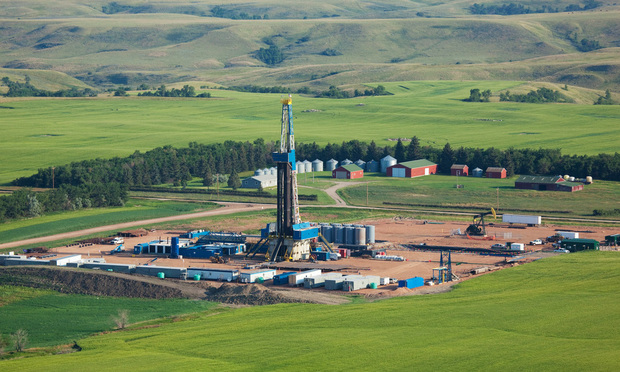Mitigating Energy Litigation Where Gaps in Jurisprudence Exist
While oil and gas litigation is now back on the Appalachian court dockets, gaps in the jurisprudence could lead to potential pitfalls for the unwary.
August 10, 2018 at 03:20 PM
6 minute read

Ever since Beaumont became a boomtown in the early 1900s, oil and gas exploration has been big business in Texas. And when business booms, litigation often follows. As a result, Texas courts have developed a rich and unbroken oil and gas jurisprudence for over a century.
Other states—particularly in Appalachia—have recently experienced booms of their own, often after decades of inactivity. For example, though Pennsylvania was an energy hub in the John D. Rockefeller era, more than a century passed before it was back on the map with the development of the Marcellus Shale. So while oil and gas litigation is now back on the Appalachian court dockets, gaps in the jurisprudence can be a trap for the unwary. What follows is an outline of some of those potential traps.
The Rule of Capture
The roots of the Rule of Capture are in English common law: if you “capture” a “fugitive” resource—like a game animal—then you own it. Take two neighbors: Jim and Jane. Jim leases his mineral rights to Company; Jane does not. Company drills a well on Jim's land and produces gas. Jane learns that gas had been beneath her land, but when Company drilled its well, the gas flowed to Jim's property, and was produced. Under the Rule of Capture, Jane has no cause of action.
In the mid-2000s, courts began confronting whether the rule applies equally to shale gas, on the theory that gas trapped in a shale is not “fugitive.” The Texas Supreme Court issued the seminal ruling in 2008, when it held in Coastal Oil & Gas Corporation v. Garza Energy Trust that the Rule of Capture applies equally to vertical and horizontal drilling. A minority of justices dissented.
But so far, Appalachian courts have taken a different view. Most recently, a Pennsylvania intermediate appellate court acknowledged Coastal Oil, but adopted the dissent's reasoning from that case. See Briggs v. Southwestern Production Co. (Pa. Super. Apr. 2, 2018). And before Briggs, a West Virginia federal court held in Stone v. Chesapeake Appalachia (N.D. W.Va. Apr. 10, 2013), that the Rule of Capture does not apply to shale gas.
There is surely more to come. Briggs is winding its way through the appellate process, and Stone was vacated: Neither is a final pronouncement of the law.
Post-Production Costs In West Virginia
Most oil and gas producing states have followed one of two rules concerning the deduction of post-production costs from royalty payments: the “at the well” rule (deductions can presumptively be taken after the gas reaches the wellhead) and the “marketable product” rule (deductions can be taken only after the gas is “marketable”). Texas was an early adopter of the “at the well” rule.
West Virginia, however, has forged its own, winding path. In 2006, in Tawney v. Columbia Natural Resources, the West Virginia Supreme Court adopted its own approach to hold that no deductions can be taken unless the lease expressly “identif[ies] with particularity the specific deductions the lessee intends to take from the lessor's royalty.” A decade later, the West Virginia Supreme Court was asked to revisit its ruling in Tawney, this time in the context of “flat rate” leases—leases where a flat royalty is paid regardless of production. In Leggett v. EQT Corporation, the West Virginia Supreme Court affirmed its ruling in Tawney.
But the court reversed itself the following year. On reconsideration, the West Virginia Supreme Court issued a sweeping opinion holding that “[r]oyalty payments pursuant to [a flat rate lease] may be subject to pro-rata deduction or allocation of all reasonable post-production expenses actually incurred by the lessee.” And in response, less than a year later, the West Virginia state legislature then effectively reversed Leggett by statute, which was signed and went into law earlier this year.
This tug-of-war between the courts and the legislature has created uncertainty about how West Virginia courts will approach post-production cost cases.
Robinson Township and the ERA
In 1971, the Pennsylvania legislature passed the Environmental Rights Amendment. The ERA broadly proclaims the rights of Pennsylvania citizens regarding environmental conservation—though the Pennsylvania Supreme Court limited the reach of the ERA just soon after its passage, holding that the ERA “create[d] no automatic right to relief.” Payne v. Kassab (Pa. 1976).
Fast-forward to 2013, when in Robinson Township v. Commonwealth (Pa. 2013), a three-justice plurality of the Pennsylvania Supreme Court breathed new life into the ERA. The Robinson plurality held sections of the Pennsylvania Oil and Gas Act that superseded local regulation of oil and gas operations unconstitutional, both because they violated the ERA and “contradicted the Commonwealth's duty as a trustee of public natural resources.”
The Pennsylvania Supreme Court confirmed Robinson in 2017 in Pennsylvania Environmental Defense Foundation v. Commonwealth (PEDF). In PEDF, the Court expressly held that the ERA limits “the state's power to act contrary to [the rights outlined in the ERA], and while the subject of [the rights] may be amenable to regulation, any laws that unreasonably impair the right[s] are unconstitutional.”
In the past year, litigants have tried to use the ERA to strike down various environmental and zoning permits issued by state regulatory and municipal bodies. But to date, Pennsylvania appellate courts have not further expanded the ERA. For example, in a June 2018 opinion, Gorsline v. Board of Supervisors of Fairfield Township, the Pennsylvania Supreme Court declined to address plaintiffs' argument that the intermediate appellate court's approval of a zoning permit violated the ERA. It remains to be seen how broadly the ERA will be applied in light of PEDF.
Dan Donovan and Ragan Naresh are litigation partners in the Kirkland & Ellis Washington, D.C., office with experience litigating energy disputes across the country. Alexandra Caritis is a litigation associate in the Firm's Houston office who has handled a variety of energy disputes, including in the restructuring context.
This content has been archived. It is available through our partners, LexisNexis® and Bloomberg Law.
To view this content, please continue to their sites.
Not a Lexis Subscriber?
Subscribe Now
Not a Bloomberg Law Subscriber?
Subscribe Now
NOT FOR REPRINT
© 2025 ALM Global, LLC, All Rights Reserved. Request academic re-use from www.copyright.com. All other uses, submit a request to [email protected]. For more information visit Asset & Logo Licensing.
You Might Like
View All

Nondisparagement Clauses in Divorce: Balancing Family Harmony and Free Speech
6 minute read

Trending Stories
- 1Chief Judge Joins Panel Exploring Causes for Public's Eroding Faith in NY Legal System
- 2Pogo Stick Maker Wants Financing Company to Pay $20M After Bailing Out Client
- 3Goldman Sachs Secures Dismissal of Celebrity Manager's Lawsuit Over Failed Deal
- 4Trump Moves to Withdraw Applications to Halt Now-Completed Sentencing
- 5Trump's RTO Mandate May Have Some Gov't Lawyers Polishing Their Resumes
Who Got The Work
J. Brugh Lower of Gibbons has entered an appearance for industrial equipment supplier Devco Corporation in a pending trademark infringement lawsuit. The suit, accusing the defendant of selling knock-off Graco products, was filed Dec. 18 in New Jersey District Court by Rivkin Radler on behalf of Graco Inc. and Graco Minnesota. The case, assigned to U.S. District Judge Zahid N. Quraishi, is 3:24-cv-11294, Graco Inc. et al v. Devco Corporation.
Who Got The Work
Rebecca Maller-Stein and Kent A. Yalowitz of Arnold & Porter Kaye Scholer have entered their appearances for Hanaco Venture Capital and its executives, Lior Prosor and David Frankel, in a pending securities lawsuit. The action, filed on Dec. 24 in New York Southern District Court by Zell, Aron & Co. on behalf of Goldeneye Advisors, accuses the defendants of negligently and fraudulently managing the plaintiff's $1 million investment. The case, assigned to U.S. District Judge Vernon S. Broderick, is 1:24-cv-09918, Goldeneye Advisors, LLC v. Hanaco Venture Capital, Ltd. et al.
Who Got The Work
Attorneys from A&O Shearman has stepped in as defense counsel for Toronto-Dominion Bank and other defendants in a pending securities class action. The suit, filed Dec. 11 in New York Southern District Court by Bleichmar Fonti & Auld, accuses the defendants of concealing the bank's 'pervasive' deficiencies in regards to its compliance with the Bank Secrecy Act and the quality of its anti-money laundering controls. The case, assigned to U.S. District Judge Arun Subramanian, is 1:24-cv-09445, Gonzalez v. The Toronto-Dominion Bank et al.
Who Got The Work
Crown Castle International, a Pennsylvania company providing shared communications infrastructure, has turned to Luke D. Wolf of Gordon Rees Scully Mansukhani to fend off a pending breach-of-contract lawsuit. The court action, filed Nov. 25 in Michigan Eastern District Court by Hooper Hathaway PC on behalf of The Town Residences LLC, accuses Crown Castle of failing to transfer approximately $30,000 in utility payments from T-Mobile in breach of a roof-top lease and assignment agreement. The case, assigned to U.S. District Judge Susan K. Declercq, is 2:24-cv-13131, The Town Residences LLC v. T-Mobile US, Inc. et al.
Who Got The Work
Wilfred P. Coronato and Daniel M. Schwartz of McCarter & English have stepped in as defense counsel to Electrolux Home Products Inc. in a pending product liability lawsuit. The court action, filed Nov. 26 in New York Eastern District Court by Poulos Lopiccolo PC and Nagel Rice LLP on behalf of David Stern, alleges that the defendant's refrigerators’ drawers and shelving repeatedly break and fall apart within months after purchase. The case, assigned to U.S. District Judge Joan M. Azrack, is 2:24-cv-08204, Stern v. Electrolux Home Products, Inc.
Featured Firms
Law Offices of Gary Martin Hays & Associates, P.C.
(470) 294-1674
Law Offices of Mark E. Salomone
(857) 444-6468
Smith & Hassler
(713) 739-1250






